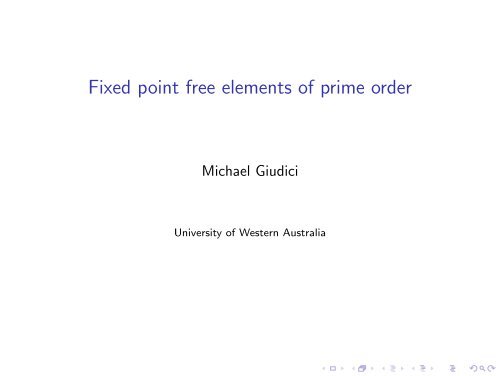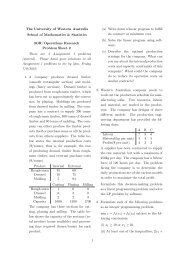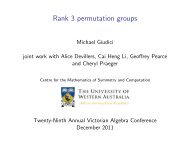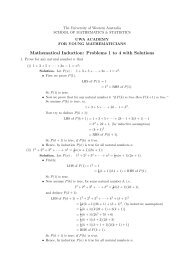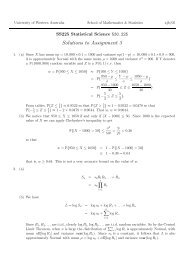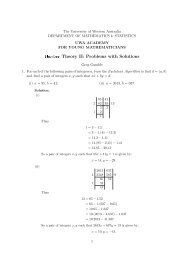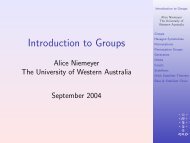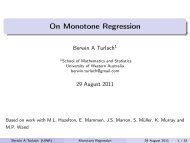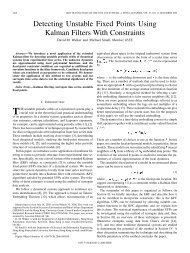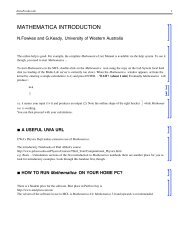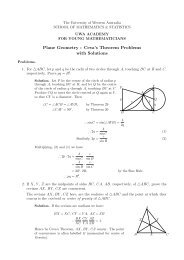Fixed point free elements of prime order - School of Maths and Stats ...
Fixed point free elements of prime order - School of Maths and Stats ...
Fixed point free elements of prime order - School of Maths and Stats ...
Create successful ePaper yourself
Turn your PDF publications into a flip-book with our unique Google optimized e-Paper software.
<strong>Fixed</strong> <strong>point</strong> <strong>free</strong> <strong>elements</strong> <strong>of</strong> <strong>prime</strong> <strong>order</strong>Michael GiudiciUniversity <strong>of</strong> Western Australia
Orbit-Counting LemmaFor a finite group G acting on a set Ω,# <strong>of</strong> orbits = 1 ∑| fix(g)||G|g∈G
How many?Let n = |Ω| > 1,G a transitive subgroup <strong>of</strong> Sym(Ω).δ(G) = proportion <strong>of</strong> fixed <strong>point</strong> <strong>free</strong> <strong>elements</strong>.
How many?Let n = |Ω| > 1,G a transitive subgroup <strong>of</strong> Sym(Ω).δ(G) = proportion <strong>of</strong> fixed <strong>point</strong> <strong>free</strong> <strong>elements</strong>.Cameron-Cohen (1992): δ(G) ≥ 1/n with equality if <strong>and</strong> only if Gis sharply 2-transitive.Guralnick-Wan (1997): If n > 6 then δ(G) > 2/n unless G aFrobenius group <strong>of</strong> <strong>order</strong> n(n − 1)/2 or n(n − 1).
How many? IIFulman-Guralnick (2003): There exists δ > 0 such that δ(G) > δfor all finite nonabelian simple groups G.
How many? IIFulman-Guralnick (2003): There exists δ > 0 such that δ(G) > δfor all finite nonabelian simple groups G.Fulman-Guralnick (2003): There exists δ > 0 such thatδ(G) > δ/ log(n) for all primitive nonaffine groups G.
What are they?Fein-Kantor-Schacher (1981): G has a fixed <strong>point</strong> <strong>free</strong> element <strong>of</strong><strong>prime</strong> power <strong>order</strong>.
What are they?Fein-Kantor-Schacher (1981): G has a fixed <strong>point</strong> <strong>free</strong> element <strong>of</strong><strong>prime</strong> power <strong>order</strong>.Generalised Isbell ConjectureThere is a function f (p, k) such that if n = p a k with p̸ k <strong>and</strong>a ≥ f (p, k) then G has a fixed <strong>point</strong> <strong>free</strong> element <strong>of</strong> p-power <strong>order</strong>.
Elusive groupsWe say that a transitive permutation group is elusive if it has n<strong>of</strong>ixed <strong>point</strong> <strong>free</strong> <strong>elements</strong> <strong>of</strong> <strong>prime</strong> <strong>order</strong>.
Elusive groupsWe say that a transitive permutation group is elusive if it has n<strong>of</strong>ixed <strong>point</strong> <strong>free</strong> <strong>elements</strong> <strong>of</strong> <strong>prime</strong> <strong>order</strong>.For example, M 11 acting on 12 <strong>point</strong>s.Existence <strong>of</strong> a fixed <strong>point</strong> <strong>free</strong> element <strong>of</strong> <strong>prime</strong> <strong>order</strong> is equivalentto existence <strong>of</strong> a semiregular subgroup.
Elusive groupsWe say that a transitive permutation group is elusive if it has n<strong>of</strong>ixed <strong>point</strong> <strong>free</strong> <strong>elements</strong> <strong>of</strong> <strong>prime</strong> <strong>order</strong>.For example, M 11 acting on 12 <strong>point</strong>s.Existence <strong>of</strong> a fixed <strong>point</strong> <strong>free</strong> element <strong>of</strong> <strong>prime</strong> <strong>order</strong> is equivalentto existence <strong>of</strong> a semiregular subgroup.G is elusive on Ω if <strong>and</strong> only if every conjugacy class <strong>of</strong> <strong>elements</strong> <strong>of</strong><strong>prime</strong> <strong>order</strong> meets G ω nontrivially.
A question <strong>of</strong> MarušičMarušič (1981): Are there any vertex-transitive digraphs with n<strong>of</strong>ixed <strong>point</strong> <strong>free</strong> automorphisms <strong>of</strong> <strong>prime</strong> <strong>order</strong>?
A question <strong>of</strong> MarušičMarušič (1981): Are there any vertex-transitive digraphs with n<strong>of</strong>ixed <strong>point</strong> <strong>free</strong> automorphisms <strong>of</strong> <strong>prime</strong> <strong>order</strong>?Independently posed by Jordan in 1988.
A question <strong>of</strong> MarušičMarušič (1981): Are there any vertex-transitive digraphs with n<strong>of</strong>ixed <strong>point</strong> <strong>free</strong> automorphisms <strong>of</strong> <strong>prime</strong> <strong>order</strong>?Independently posed by Jordan in 1988.A digraph is a Cayley digraph if <strong>and</strong> only if its automorphism groupcontains a regular subgroup.
A question <strong>of</strong> MarušičMarušič (1981): Are there any vertex-transitive digraphs with n<strong>of</strong>ixed <strong>point</strong> <strong>free</strong> automorphisms <strong>of</strong> <strong>prime</strong> <strong>order</strong>?Independently posed by Jordan in 1988.A digraph is a Cayley digraph if <strong>and</strong> only if its automorphism groupcontains a regular subgroup.Many methods for constructing Hamiltonian cycles use existence <strong>of</strong>such an automorphism.
Nice representationsBiggs 197300 1100 1100 1100 1100 1100 115 | 100 11Petersen graph00 11 00 1100 11 00 1100 115 | 2
Nice representationsBiggs 197300 1100 1100 1100 1100 1100 115 | 100 11Petersen graph00 11 00 1100 11 00 1100 115 | 2000 11100 1100 1100 1100 1100 1100 1100 1100 1100 1100 1100 11 00 1100 1100 1100 1100 1100 1100 11 00 1100 1100 1100 1100 1100 1100 1100 1100 117 | 100 11 00 1100 1100 117 | 47 | 2Coxeter graph
Nice representations II00110011001100110011001100110011001100110011001100110011001100110011001100110011001100110011001100110011001100110011 0011001100110011001100110011001100110011001100110011001100110011001100110011001100110011001100110011 001100110011001100110011001100110011001100110011001100110011001100110011001100110011001100110011 0011001100110011001100110011001100110011001100110011001100110011 00110011001100110011001100110011001100110011 00110011001117 | 2 17 | 117 | 417 | 8Biggs-Smith graph
2-closuresThe 2-closure G (2) <strong>of</strong> G is the group <strong>of</strong> all permutations <strong>of</strong> Ωwhich fix setwise each orbit <strong>of</strong> G on Ω × Ω.
2-closuresThe 2-closure G (2) <strong>of</strong> G is the group <strong>of</strong> all permutations <strong>of</strong> Ωwhich fix setwise each orbit <strong>of</strong> G on Ω × Ω.If G is 2-transitive on Ω then G (2) = Sym(Ω).
2-closuresThe 2-closure G (2) <strong>of</strong> G is the group <strong>of</strong> all permutations <strong>of</strong> Ωwhich fix setwise each orbit <strong>of</strong> G on Ω × Ω.If G is 2-transitive on Ω then G (2) = Sym(Ω).G (2) preserves all systems <strong>of</strong> imprimitivity for G.
2-closuresThe 2-closure G (2) <strong>of</strong> G is the group <strong>of</strong> all permutations <strong>of</strong> Ωwhich fix setwise each orbit <strong>of</strong> G on Ω × Ω.If G is 2-transitive on Ω then G (2) = Sym(Ω).G (2) preserves all systems <strong>of</strong> imprimitivity for G.We say that G is 2-closed if G = G (2) .
2-closuresThe 2-closure G (2) <strong>of</strong> G is the group <strong>of</strong> all permutations <strong>of</strong> Ωwhich fix setwise each orbit <strong>of</strong> G on Ω × Ω.If G is 2-transitive on Ω then G (2) = Sym(Ω).G (2) preserves all systems <strong>of</strong> imprimitivity for G.We say that G is 2-closed if G = G (2) .The full automorphism group <strong>of</strong> a digraph is 2-closed.
Polycirculant conjectureKlin (1997) extended the question <strong>of</strong> Marušič to 2-closed groups.
Polycirculant conjectureKlin (1997) extended the question <strong>of</strong> Marušič to 2-closed groups.Polycirculant ConjectureEvery finite transitive 2-closed permutation group has a fixed <strong>point</strong><strong>free</strong> element <strong>of</strong> <strong>prime</strong> <strong>order</strong>.
Polycirculant conjectureKlin (1997) extended the question <strong>of</strong> Marušič to 2-closed groups.Polycirculant ConjectureEvery finite transitive 2-closed permutation group has a fixed <strong>point</strong><strong>free</strong> element <strong>of</strong> <strong>prime</strong> <strong>order</strong>.In action on 12 <strong>point</strong>s, (M 11 ) (2) = S 12 .
Early resultsMarušič (1981): All transitive permutation groups <strong>of</strong> degree p k ormp, for some <strong>prime</strong> p <strong>and</strong> m < p, have a fixed <strong>point</strong> <strong>free</strong> element<strong>of</strong> <strong>order</strong> p.
Early resultsMarušič (1981): All transitive permutation groups <strong>of</strong> degree p k ormp, for some <strong>prime</strong> p <strong>and</strong> m < p, have a fixed <strong>point</strong> <strong>free</strong> element<strong>of</strong> <strong>order</strong> p.Marušič <strong>and</strong> Scapellato (1993):• All cubic vertex-transitive graphs have a fixed <strong>point</strong> <strong>free</strong>automorphism <strong>of</strong> <strong>prime</strong> <strong>order</strong>.
Early resultsMarušič (1981): All transitive permutation groups <strong>of</strong> degree p k ormp, for some <strong>prime</strong> p <strong>and</strong> m < p, have a fixed <strong>point</strong> <strong>free</strong> element<strong>of</strong> <strong>order</strong> p.Marušič <strong>and</strong> Scapellato (1993):• All cubic vertex-transitive graphs have a fixed <strong>point</strong> <strong>free</strong>automorphism <strong>of</strong> <strong>prime</strong> <strong>order</strong>.• A vertex-transitive digraph <strong>of</strong> <strong>order</strong> 2p 2 has a fixed <strong>point</strong> <strong>free</strong>automorphism <strong>of</strong> <strong>order</strong> p.
Fein-Kantor-Schacher examplesAGL(1, p 2 ), for p a Mersenne <strong>prime</strong>, acting on the set <strong>of</strong> p(p + 1)lines <strong>of</strong> the affine plane AG(2, p).
Fein-Kantor-Schacher examplesAGL(1, p 2 ), for p a Mersenne <strong>prime</strong>, acting on the set <strong>of</strong> p(p + 1)lines <strong>of</strong> the affine plane AG(2, p).All <strong>elements</strong> <strong>of</strong> <strong>order</strong> 2 <strong>and</strong> p fix a line so action is elusive.
Fein-Kantor-Schacher examplesAGL(1, p 2 ), for p a Mersenne <strong>prime</strong>, acting on the set <strong>of</strong> p(p + 1)lines <strong>of</strong> the affine plane AG(2, p).All <strong>elements</strong> <strong>of</strong> <strong>order</strong> 2 <strong>and</strong> p fix a line so action is elusive.2-closure contains C p+1pwhose p + 1 orbits are the parallel classes.AΓL(1, p 2 ) is also elusive in this action.
More constructionsCameron-MG-Jones-Kantor-Klin-Marušič-Nowitz (2002)Suppose G 1 , G 2 are elusive groups on the sets Ω 1 , Ω 2 respectively.Then• G 1 × G 2 is elusive on Ω 1 × Ω 2 .• G 1 wr G 2 is elusive on Ω 1 × Ω 2 .
More constructionsCameron-MG-Jones-Kantor-Klin-Marušič-Nowitz (2002)Suppose G 1 , G 2 are elusive groups on the sets Ω 1 , Ω 2 respectively.Then• G 1 × G 2 is elusive on Ω 1 × Ω 2 .• G 1 wr G 2 is elusive on Ω 1 × Ω 2 .• G 1 wr S n is elusive on Ω n .
General affine constructionCameron-MG-Jones-Kantor-Klin-Marušič-Nowitz (2002)• V a vector space over a field <strong>of</strong> characteristic p,• G 1 GL(V ) with <strong>order</strong> <strong>prime</strong> to p,• W a subspace <strong>of</strong> V ,• H 1 < G 1 fixes W setwise.
General affine constructionCameron-MG-Jones-Kantor-Klin-Marušič-Nowitz (2002)• V a vector space over a field <strong>of</strong> characteristic p,• G 1 GL(V ) with <strong>order</strong> <strong>prime</strong> to p,• W a subspace <strong>of</strong> V ,• H 1 < G 1 fixes W setwise.The action <strong>of</strong> V ⋊ G 1 on the set <strong>of</strong> right cosets <strong>of</strong> W ⋊ H 1 iselusive if <strong>and</strong> only if1 the images <strong>of</strong> W under G 1 cover V , <strong>and</strong>2 every conjugacy class <strong>of</strong> <strong>elements</strong> <strong>of</strong> <strong>prime</strong> <strong>order</strong> in G 1 meetsH 1 .
FKS examples againAGL(1, p 2 ) ∼ = C 2 p ⋊ C p 2 −1
FKS examples againAGL(1, p 2 ) ∼ = C 2 p ⋊ C p 2 −1Stabiliser <strong>of</strong> a line is isomorphic to C p ⋊ C p−1
FKS examples againAGL(1, p 2 ) ∼ = C 2 p ⋊ C p 2 −1Stabiliser <strong>of</strong> a line is isomorphic to C p ⋊ C p−1G 1 = C p 2 −1 GL(2, p), W a 1-dimensional subspace, H 1 = C p−1
FKS examples againAGL(1, p 2 ) ∼ = C 2 p ⋊ C p 2 −1Stabiliser <strong>of</strong> a line is isomorphic to C p ⋊ C p−1G 1 = C p 2 −1 GL(2, p), W a 1-dimensional subspace, H 1 = C p−11 G 1 acts transitively on nontrivial <strong>elements</strong> <strong>of</strong> V .
FKS examples againAGL(1, p 2 ) ∼ = C 2 p ⋊ C p 2 −1Stabiliser <strong>of</strong> a line is isomorphic to C p ⋊ C p−1G 1 = C p 2 −1 GL(2, p), W a 1-dimensional subspace, H 1 = C p−11 G 1 acts transitively on nontrivial <strong>elements</strong> <strong>of</strong> V .2 Only <strong>prime</strong>s dividing p 2 − 1 are those dividing p − 1.
FKS examples againAGL(1, p 2 ) ∼ = C 2 p ⋊ C p 2 −1Stabiliser <strong>of</strong> a line is isomorphic to C p ⋊ C p−1G 1 = C p 2 −1 GL(2, p), W a 1-dimensional subspace, H 1 = C p−11 G 1 acts transitively on nontrivial <strong>elements</strong> <strong>of</strong> V .2 Only <strong>prime</strong>s dividing p 2 − 1 are those dividing p − 1.
FKS examples againAGL(1, p 2 ) ∼ = C 2 p ⋊ C p 2 −1Stabiliser <strong>of</strong> a line is isomorphic to C p ⋊ C p−1G 1 = C p 2 −1 GL(2, p), W a 1-dimensional subspace, H 1 = C p−11 G 1 acts transitively on nontrivial <strong>elements</strong> <strong>of</strong> V .2 Only <strong>prime</strong>s dividing p 2 − 1 are those dividing p − 1.In fact, any group C 2 p ⋊ G 1 , where G 1 C p 2 −1 contains theSylow 2-subgroup, is elusive.
Some more affine examples• V = GF(7 3 ), W a 2-dimensional subspace, G 1 = 3 1+2 ⋊ Q 8 ,H 1 = 3 2 ⋊ C 2 . (CGJKLMN 2002)
Some more affine examples• V = GF(7 3 ), W a 2-dimensional subspace, G 1 = 3 1+2 ⋊ Q 8 ,H 1 = 3 2 ⋊ C 2 . (CGJKLMN 2002)• p a Mersenne <strong>prime</strong>, V = GF(2) p2 −1 , W a hyperplane,G 1 = AΓL(1, p 2 ), H 1 = (C p ⋊ C p−1 ) × C 2 . (MG 2007)
Some more affine examples• V = GF(7 3 ), W a 2-dimensional subspace, G 1 = 3 1+2 ⋊ Q 8 ,H 1 = 3 2 ⋊ C 2 . (CGJKLMN 2002)• p a Mersenne <strong>prime</strong>, V = GF(2) p2 −1 , W a hyperplane,G 1 = AΓL(1, p 2 ), H 1 = (C p ⋊ C p−1 ) × C 2 . (MG 2007)• V = GF(2) 8 , W a codimension 2 space,G 1 = AΓL(1, 9), H 1 = (C 3 ⋊ C 2 ) × C 2 . (MG 2007)
Hensel lifting constructionCameron-MG-Jones-Kantor-Klin-Marušič-Nowitz (2002)• V , G 1 , W <strong>and</strong> H 1 as in affine construction.• V dimension d over GF(p).• W dimension k.
Hensel lifting constructionCameron-MG-Jones-Kantor-Klin-Marušič-Nowitz (2002)• V , G 1 , W <strong>and</strong> H 1 as in affine construction.• V dimension d over GF(p).• W dimension k.Then for any m > 1, the action <strong>of</strong> (C p m) d ⋊ G 1 on the set <strong>of</strong>cosets <strong>of</strong> (C p m) k ⋊ H 1 is elusive <strong>of</strong> degree p km |G 1 : H 1 |.
Hensel lifting constructionCameron-MG-Jones-Kantor-Klin-Marušič-Nowitz (2002)• V , G 1 , W <strong>and</strong> H 1 as in affine construction.• V dimension d over GF(p).• W dimension k.Then for any m > 1, the action <strong>of</strong> (C p m) d ⋊ G 1 on the set <strong>of</strong>cosets <strong>of</strong> (C p m) k ⋊ H 1 is elusive <strong>of</strong> degree p km |G 1 : H 1 |.This takes elusive groups <strong>of</strong> degree d <strong>and</strong> builds new ones withdegree p m d.
Priming ConstructionMG 2007Input:• V ⋊ 〈a〉 elusive <strong>of</strong> degree n,• 〈a〉 irreducible on V with <strong>order</strong> <strong>prime</strong> to p,• <strong>point</strong> stabiliser W ⋊ 〈b〉,• r a <strong>prime</strong> dividing |a|.
Priming ConstructionMG 2007Input:• V ⋊ 〈a〉 elusive <strong>of</strong> degree n,• 〈a〉 irreducible on V with <strong>order</strong> <strong>prime</strong> to p,• <strong>point</strong> stabiliser W ⋊ 〈b〉,• r a <strong>prime</strong> dividing |a|.Let• V ′ = V}⊕ ·{{· · ⊕ V}, W ′ = W ⊕ V ⊕ · · · ⊕ Vr copies• g = (1, . . . , 1, a)τ where τ = (12 . . . r)
Priming ConstructionMG 2007Input:• V ⋊ 〈a〉 elusive <strong>of</strong> degree n,• 〈a〉 irreducible on V with <strong>order</strong> <strong>prime</strong> to p,• <strong>point</strong> stabiliser W ⋊ 〈b〉,• r a <strong>prime</strong> dividing |a|.Let• V ′ = V}⊕ ·{{· · ⊕ V}, W ′ = W ⊕ V ⊕ · · · ⊕ Vr copies• g = (1, . . . , 1, a)τ where τ = (12 . . . r)Then V ′ ⋊ 〈g〉 acts elusively on the set <strong>of</strong> right cosets <strong>of</strong>W ′ ⋊ 〈(b, . . . , b)〉 with degree rn.
Priming Construction IIUsing the FKS examples as a starting <strong>point</strong>, we get elusive groupsfor all degreesp2 n r j 11 . . . r tjtwhere• p Mersenne,• 2 n > p,• r 1 , . . . , r t are distinct odd <strong>prime</strong>s dividing p − 1,• j i ≥ 0.
Priming Construction IIUsing the FKS examples as a starting <strong>point</strong>, we get elusive groupsfor all degreesp2 n r j 11 . . . r tjtwhere• p Mersenne,• 2 n > p,• r 1 , . . . , r t are distinct odd <strong>prime</strong>s dividing p − 1,• j i ≥ 0.Using Hensel lifting construction can also multiply by powers <strong>of</strong> p.
A characterisationTheorem (MG-Kelly 2008+)Let G be an elusive permutation group such that G = N ⋊ G 1 forN an elementary abelian minimal normal subgroup <strong>and</strong> G 1 cyclic.Then G can be obtained by repeatedly applying the primingconstruction to an FKS-group.
Primitive groups <strong>and</strong> generalisationsLet G Sym(Ω) transitive• G is primitive if there are no nontrivial partitions <strong>of</strong> Ωpreserved by G.
Primitive groups <strong>and</strong> generalisationsLet G Sym(Ω) transitive• G is primitive if there are no nontrivial partitions <strong>of</strong> Ωpreserved by G.• G is quasiprimitive if all nontrivial normal subgroup <strong>of</strong> G aretransitive.
Primitive groups <strong>and</strong> generalisationsLet G Sym(Ω) transitive• G is primitive if there are no nontrivial partitions <strong>of</strong> Ωpreserved by G.• G is quasiprimitive if all nontrivial normal subgroup <strong>of</strong> G aretransitive.• G is biquasiprimitive if G is not quasiprimitive <strong>and</strong> allnontrivial normal subgroups have at most two orbits.
ClassificationsTheorem (MG 2003)The only almost simple elusive groups are M 11 <strong>and</strong> M 10 = A 6. 2acting on 12 <strong>point</strong>s.
ClassificationsTheorem (MG 2003)The only almost simple elusive groups are M 11 <strong>and</strong> M 10 = A 6. 2acting on 12 <strong>point</strong>s.Theorem (MG 2003)Let G be an elusive permutation group with a transitive minimalnormal subgroup. Then G = M 11 wr K acting on 12 k <strong>point</strong>s withK a transitive subgroup <strong>of</strong> S k .
ClassificationsTheorem (MG 2003)The only almost simple elusive groups are M 11 <strong>and</strong> M 10 = A 6. 2acting on 12 <strong>point</strong>s.Theorem (MG 2003)Let G be an elusive permutation group with a transitive minimalnormal subgroup. Then G = M 11 wr K acting on 12 k <strong>point</strong>s withK a transitive subgroup <strong>of</strong> S k .2-closures <strong>of</strong> exceptions contain S k 12 .
ClassificationsTheorem (MG 2003)The only almost simple elusive groups are M 11 <strong>and</strong> M 10 = A 6. 2acting on 12 <strong>point</strong>s.Theorem (MG 2003)Let G be an elusive permutation group with a transitive minimalnormal subgroup. Then G = M 11 wr K acting on 12 k <strong>point</strong>s withK a transitive subgroup <strong>of</strong> S k .2-closures <strong>of</strong> exceptions contain S k 12 .All minimal normal subgroups <strong>of</strong> a counterexample to thepolycirculant conjecture must be intransitive.
Classifications IITheorem (MG-Xu 2007)Let G be a biquasiprimitive elusive permutation group on Ω. Thenone <strong>of</strong> the following holds:1 G = M 10 <strong>and</strong> |Ω| = 12;2 G = M 11 wr K <strong>and</strong> |Ω| = 2(12 k ), where K S k is transitivewith an index two subgroup;3 G = M 11 wr K <strong>and</strong> |Ω| = 2(12) k/2 , where K S k is transitivewith an index two intransitive subgroup.
Classifications IITheorem (MG-Xu 2007)Let G be a biquasiprimitive elusive permutation group on Ω. Thenone <strong>of</strong> the following holds:1 G = M 10 <strong>and</strong> |Ω| = 12;2 G = M 11 wr K <strong>and</strong> |Ω| = 2(12 k ), where K S k is transitivewith an index two subgroup;3 G = M 11 wr K <strong>and</strong> |Ω| = 2(12) k/2 , where K S k is transitivewith an index two intransitive subgroup.CorollaryLet G be a biquasiprimitive elusive permutation group on Ω. ThenG (2) is not elusive.
Locally quasiprimitive graphsΓ a graph, G Aut(Γ).
Locally quasiprimitive graphsΓ a graph, G Aut(Γ).Γ is G-locally quasiprimitive if for all vertices v, G v isquasiprimitive on Γ(v).
Locally quasiprimitive graphsΓ a graph, G Aut(Γ).Γ is G-locally quasiprimitive if for all vertices v, G v isquasiprimitive on Γ(v).A 2-arc in a graph is a triple (v 0 , v 1 , v 2 ) such that v 0 ∼ v 1 ∼ v 2<strong>and</strong> v 0 ≠ v 2 .
Locally quasiprimitive graphsΓ a graph, G Aut(Γ).Γ is G-locally quasiprimitive if for all vertices v, G v isquasiprimitive on Γ(v).A 2-arc in a graph is a triple (v 0 , v 1 , v 2 ) such that v 0 ∼ v 1 ∼ v 2<strong>and</strong> v 0 ≠ v 2 .Γ is 2-arc transitive if Aut(Γ) is transitive on the set <strong>of</strong> 2-arcs in Γ.
Locally quasiprimitive graphsΓ a graph, G Aut(Γ).Γ is G-locally quasiprimitive if for all vertices v, G v isquasiprimitive on Γ(v).A 2-arc in a graph is a triple (v 0 , v 1 , v 2 ) such that v 0 ∼ v 1 ∼ v 2<strong>and</strong> v 0 ≠ v 2 .Γ is 2-arc transitive if Aut(Γ) is transitive on the set <strong>of</strong> 2-arcs in Γ.A vertex-transitive graph is 2-arc-transitive if <strong>and</strong> only if G v is2-transitive on Γ(v) for all v.
Locally quasiprimitive graphs IITheorem (Praeger 1985)Let Γ be a finite connected G-vertex-transitive,G-locally-quasiprimitive graph <strong>and</strong> let 1 ≠ N ⊳ G. If N has atleast three vertex-orbits then it is semiregular.
Locally quasiprimitive graphs IITheorem (Praeger 1985)Let Γ be a finite connected G-vertex-transitive,G-locally-quasiprimitive graph <strong>and</strong> let 1 ≠ N ⊳ G. If N has atleast three vertex-orbits then it is semiregular.CorollaryEither G contains a semiregular subgroup, or G is quasiprimitive orbiquasiprimitive on vertices.
Locally quasiprimitive graphs IIITheorem (MG-Xu 2007)Every vertex-transitive, locally quasiprimitive graph has a fixed<strong>point</strong> <strong>free</strong> automorphism <strong>of</strong> <strong>prime</strong> <strong>order</strong>.
Locally quasiprimitive graphs IIITheorem (MG-Xu 2007)Every vertex-transitive, locally quasiprimitive graph has a fixed<strong>point</strong> <strong>free</strong> automorphism <strong>of</strong> <strong>prime</strong> <strong>order</strong>.CorollaryEvery 2-arc-transitive graph has a fixed <strong>point</strong> <strong>free</strong> automorphism <strong>of</strong><strong>prime</strong> <strong>order</strong>.
Locally quasiprimitive graphs IIITheorem (MG-Xu 2007)Every vertex-transitive, locally quasiprimitive graph has a fixed<strong>point</strong> <strong>free</strong> automorphism <strong>of</strong> <strong>prime</strong> <strong>order</strong>.CorollaryEvery 2-arc-transitive graph has a fixed <strong>point</strong> <strong>free</strong> automorphism <strong>of</strong><strong>prime</strong> <strong>order</strong>.CorollaryEvery arc-transitive graph <strong>of</strong> <strong>prime</strong> valency has a fixed <strong>point</strong> <strong>free</strong>automorphism <strong>of</strong> <strong>prime</strong> <strong>order</strong>.
Some more resultsDobson-Malnič-Marušič-Nowitz (2007):• All quartic vertex-transitive graphs have a fixed <strong>point</strong> <strong>free</strong>automorphism <strong>of</strong> <strong>prime</strong> <strong>order</strong>.
Some more resultsDobson-Malnič-Marušič-Nowitz (2007):• All quartic vertex-transitive graphs have a fixed <strong>point</strong> <strong>free</strong>automorphism <strong>of</strong> <strong>prime</strong> <strong>order</strong>.• All vertex-transitive graphs <strong>of</strong> valency p + 1 admitting atransitive {2, p}-group for p odd have a fixed <strong>point</strong> <strong>free</strong>automorphism <strong>of</strong> <strong>prime</strong> <strong>order</strong>.
Some more resultsDobson-Malnič-Marušič-Nowitz (2007):• All quartic vertex-transitive graphs have a fixed <strong>point</strong> <strong>free</strong>automorphism <strong>of</strong> <strong>prime</strong> <strong>order</strong>.• All vertex-transitive graphs <strong>of</strong> valency p + 1 admitting atransitive {2, p}-group for p odd have a fixed <strong>point</strong> <strong>free</strong>automorphism <strong>of</strong> <strong>prime</strong> <strong>order</strong>.• There are no elusive 2-closed groups <strong>of</strong> square-<strong>free</strong> degree.
Some more resultsDobson-Malnič-Marušič-Nowitz (2007):• All quartic vertex-transitive graphs have a fixed <strong>point</strong> <strong>free</strong>automorphism <strong>of</strong> <strong>prime</strong> <strong>order</strong>.• All vertex-transitive graphs <strong>of</strong> valency p + 1 admitting atransitive {2, p}-group for p odd have a fixed <strong>point</strong> <strong>free</strong>automorphism <strong>of</strong> <strong>prime</strong> <strong>order</strong>.• There are no elusive 2-closed groups <strong>of</strong> square-<strong>free</strong> degree.Xu (2008): All arc-transitive graphs with valency pq, p, q <strong>prime</strong>s,such that Aut(Γ) has a nonabelian minimal normal subgroup Nwith at least 3 vertex orbits, has a semiregular automorphism.
Open problems <strong>and</strong> questions• Prove the polycirculant conjecture.
Open problems <strong>and</strong> questions• Prove the polycirculant conjecture.• Prove the polycirculant conjecture for arc-transitive graphs.
Open problems <strong>and</strong> questions• Prove the polycirculant conjecture.• Prove the polycirculant conjecture for arc-transitive graphs.• Find new constructions <strong>of</strong> elusive groups.
Open problems <strong>and</strong> questions• Prove the polycirculant conjecture.• Prove the polycirculant conjecture for arc-transitive graphs.• Find new constructions <strong>of</strong> elusive groups.• For what degrees do elusive groups exist? (smallest degree forwhich existence is unknown is 40.)
Open problems <strong>and</strong> questions• Prove the polycirculant conjecture.• Prove the polycirculant conjecture for arc-transitive graphs.• Find new constructions <strong>of</strong> elusive groups.• For what degrees do elusive groups exist? (smallest degree forwhich existence is unknown is 40.)• Does the set <strong>of</strong> all such degrees have density 0?
Open problems <strong>and</strong> questions• Prove the polycirculant conjecture.• Prove the polycirculant conjecture for arc-transitive graphs.• Find new constructions <strong>of</strong> elusive groups.• For what degrees do elusive groups exist? (smallest degree forwhich existence is unknown is 40.)• Does the set <strong>of</strong> all such degrees have density 0?http://www.maths.uwa.edu.au/∼giudici/research.html
Group Theory, Combinatorics <strong>and</strong> ComputationAMSI theme program at The University <strong>of</strong> Western Australia5 th − 16 th January 2009First week international conference in honour <strong>of</strong> Cheryl Praeger’s60 th birthday.Informal second week consisting <strong>of</strong> short courses <strong>and</strong> problemsessions.For more information, seehttp://sponsored.uwa.edu.au/gcc09/welcome


